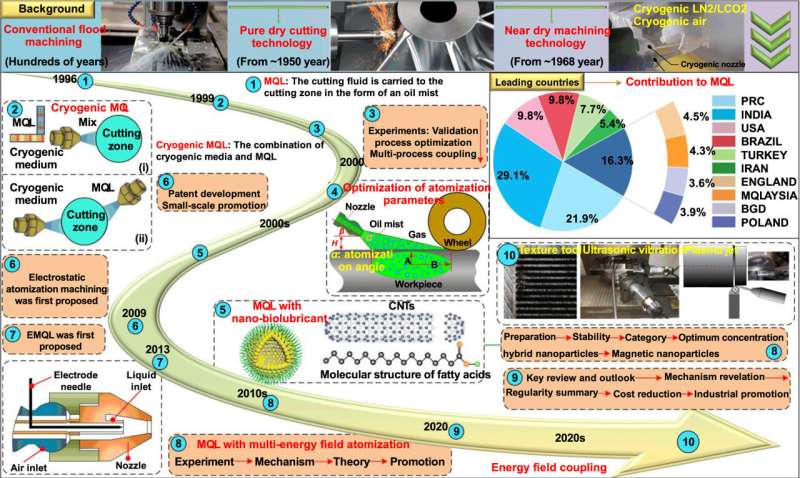Development history of MQL. Credit: International Journal of Extreme Manufacturing (2022). DOI: 10.1088/2631-7990/ac9652
Scientists from Qingdao University of Technology for the first time summarized the development status and technical bottlenecks of electrostatic atomization minimum quantity lubrication (MQL) to further promote the green transformation of manufacturing industry.
Publishing in the International Journal of Extreme Manufacturing, the team led by researchers based at the Intelligent and Sustainable Precision Manufacturing Lab (ISPM) reviewed the research status of electrostatic minimum quantity lubrication (EMQL), the frontier technology of clean cutting in order to better reveal the unique machining mechanism of electrostatic atomization.
The team mainly carried out the following work. First, the critical equipment, eco-friendly atomization media, and empowering mechanisms of electrostatic atomization MQL are presented. Second, the advanced lubrication and heat transfer mechanisms of biolubricants are revealed by quantitatively comparing MQL with MCF-based wet machining. Third, the distinctive wetting and infiltration mechanisms of electrostatic atomization MQL, combined with its unique empowering mechanism and atomization method, are compared with those of pneumatic atomization MQL. Finally, future development directions, including the improvement of the coordination parameters and equipment integration aspects, are proposed.
Professor Li Changhe is an authority on nanofluid MQL and electrostatic atomization MQL research. He said, "It is an effective scheme to reduce the harm of nanoparticles to workers' health by improving the adsorption capacity of droplets. However, both the stability of the electrostatic atomization MQL system and the stability of the atomization medium are the bottlenecks of this technology."
One of the lead researchers, Professor Zhang Yanbin, said, "Traditional pneumatic atomization MQL has been puzzling users for a long time due to its severe oil mist dispersion. Electrostatic atomization MQL effectively inhibits the increase of oil mist in laboratories and factories with its excellent charging performance. However, researchers are still unable to understand the working mechanism of this technology. In our work, the principle and research hotspot of this technology are introduced in detail, and the current technical bottleneck of this technology is emphasized. In this way, we hope to attract the attention of scientists."
By analyzing the machining mechanism and application bottleneck of potential green atomization medium (biolubricant), researchers were expected to capture the next development direction of biolubricant.
The team analyzed the scientific and engineering problems of biolubricant and electrostatic atomization MQL based on the existing technology, which is conducive to the practical promotion of this technology.
Dr. Yang Min said, "This paper summarizes the milestones of clean-cutting technology. It is also meaningful to comment on the current development status of MQL and point out the future development trend."
More information: Wenhao Xu et al, Electrostatic atomization minimum quantity lubrication machining: from mechanism to application, International Journal of Extreme Manufacturing (2022). DOI: 10.1088/2631-7990/ac9652
Provided by International Journal of Extreme Manufacturing
























